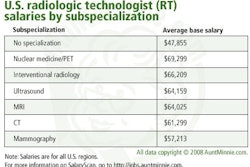Radiology administrators need to get savvier about the politics and economics of U.S. reimbursement to counter the natural advantage that private payors have regarding payment for imaging services, according to a presentation this week at the 2008 American Healthcare Radiology Administrators (AHRA) meeting in Denver.
Individual imaging services providers are geographically splintered and isolated, which works to the advantage of private payors, who often have more current and comprehensive data at their fingertips regarding reimbursement for imaging services, according to Michael Longacre, a reimbursement strategy consultant for HealthCare Market Strategies of Yamhill, OR.
"Health insurance companies have the upper hand when it comes to data about claims and payment for diagnostic procedures and professional services. They have it and you don't," Longacre told AHRA attendees.
If radiology departments and imaging centers can develop a more comprehensive understanding of private payors' reimbursement practices at the regional and national levels, they will have more power to negotiate with individual payors, Longacre advised.
A number of factors are contributing to a decline in reimbursement for diagnostic imaging services. The Deficit Reduction Act (DRA) of 2005 is reducing revenue at imaging centers by 30% to 40%. Five-year cost averaging evaluates cost-to-charge expenses, and payments are being reduced as diagnostic equipment drops in price. The bundling of procedures under a single ambulatory payment classification may also reduce total reimbursement.
Health insurance companies are increasingly relying on radiology benefits management companies, which may or may not have clinically astute staff making decisions. Some also are recalculating relative value units, and as a result, reimbursement may be less than that received by Medicare. In fact, one such company, Ingenix, an Eden Prairie, MN, subsidiary of UnitedHealthcare, is being sued by the state of New York for allegedly using a defective and manipulated database to provide insurers with fraudulent pricing for medical care.
Additionally, third-party payors have taken notice of the pricing differences between hospitals and freestanding imaging centers, and radiologists are increasingly taking their reimbursement losses to hospitals' doorsteps for resolution, according to Longacre. All of these factors equate to reduced revenue and the need to better understand the economics, policies, and strategies underlying reimbursement.
Common CPT misconception
A common misconception is that just because a procedure has a current procedural terminology (CPT) I code, it will be reimbursed. "Just because Medicare pays, it doesn't mean that private payors will," Longacre cautioned.
The benefit of a CPT I code is that the procedure is presented to an American Medical Association (AMA) committee of knowledgeable specialists, who will evaluate its cost, determine a reasonable reimbursement rate, and make a recommendation to Medicare.
Medicare typically uses a CPT III code for new technologies and procedures. This code is characterized by the fact that the procedure the code represents does not yet have broad utilization, and prospective, randomized, double-blind clinical trials seldom have been completed to prove its utility. The value of the CPT III code is that it includes a reporting mechanism, and while the chances of receiving reimbursement may be minimal, it is extremely important for claims to be filed as CPT III procedures so that usage data can be calculated.
Yet approximately 44% of all CPT III codes have a listed reimbursement value for the technical component. To date, none list professional fee reimbursement, but this can potentially be negotiated with insurance companies.
"It is the responsibility of vendors of new technologies to support customers in their efforts to be reimbursed for CPT III codes," Longacre said. "When a vendor tries to sell you a new technology, you need to ask, 'What is the code?' and 'What are the suggested reimbursement values?' "
"When a vendor can support a customer with a utilization strategy, everybody benefits. The customer can achieve a more rapid return on investment, and the vendor can potentially sell more of its new technology," Longacre said.
Vendors should supply customers with peer-review articles about the technology, advice about claims strategy, and information about healthcare facilities that are achieving reimbursement. Unfortunately, all too frequently, vendors restrict information about success or failure to only users of their products, rather than using a multivendor customer base that utilizes the new technology, Longacre said.
Going under the radar
Be mindful of economics and of politics, Longacre suggested. "It's better to accept a lack of stated policy and reimbursement by a private payor than to fight to the point where the payor denies payment." He pointed out that public "no payment" policies have a way of multiplying, because if one insurance company publicly denies claims, others will follow.
With CPT III codes, sometimes it is better to go under the radar, and accept reimbursement when it is received. If a track record of reimbursement can be made with some payors, it may be a better strategy to return to the nonpayor and ask them to re-evaluate.
While it is illegal for individual healthcare facilities to share claims and reimbursement information, they can pool their knowledge about the reimbursement policies and practices of individual insurance companies. Being knowledgeable about the practices of many private payors, including those outside a healthcare facility's geographic turf, can arm radiology administrators with stronger arguments for payment when combating denials of claims.
"Payors don't want to be the first ones to pay for anything. Your case will be stronger if you can identify other health insurance companies that are providing reimbursement," Longacre said.
He recommended that integrated delivery networks or group purchasing organizations such as Premier of Charlotte, NC, serve as resources for pooling information about which providers are paying and for what. An in-depth understanding of regional and national insurance reimbursement trends will enable individual radiology administrators to make stronger arguments for their claims.
By Cynthia Keen
AuntMinnie.com staff writer
July 28, 2008
Related Reading
Reimbursement 101: How vendors can help you get paid, August 24, 2007
Copyright © 2008 AuntMinnie.com



















